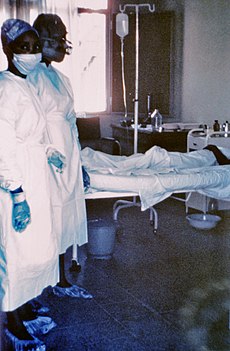Ebola virus disease
0
Ebola virus disease (EVD; also Ebola hemorrhagic fever [EHF]), or simply Ebola, is a disease of humans and other primates caused by ebolaviruses (EBOV). Signs and symptoms typically start between two days and three weeks after contracting the virus as afever, sore throat, muscle pain and headaches. Then, vomiting, diarrhea and rash usually follow, along with decreased function of the liver and kidneys. At this time some people begin to bleed both internally and externally.[1] Death, if it occurs, follows typically six to sixteen days after symptoms appear and is often due to low blood pressure from fluid loss.[2]
The virus spreads by direct contact with blood or other body fluids of an infected human or other animal.[1] Infection with the virus may also occur by direct contact with a recently contaminated item or surface.[1] Spread of the disease through the air has not been documented in the natural environment.[3] EBOV may be spread by semen or breast milk for several weeks to months after recovery.[1][4] Fruit bats are believed to be the normal carrier in nature, able to spread the virus without being affected by it. Humans become infected by contact with the bats or with a living or dead animal that has been infected by bats. After human infection occurs, the disease may also spread between people. Other diseases such as malaria, cholera, typhoid fever, meningitis and other viral hemorrhagic fevers may resemble EVD. Blood samples are tested for viral RNA, viral antibodies or for the virus itself to confirm the diagnosis.[1]
Control of outbreaks requires coordinated medical services, along with a certain level of community engagement. The medical services include: rapid detection of cases of disease,contact tracing of those who have come into contact with infected individuals, quick access to laboratory services, proper care and management of those who are infected and proper disposal of the dead through cremation or burial.[1][5] Prevention includes limiting the spread of disease from infected animals to humans.[1] This may be done by handling potentially infected bush meat only while wearing protective clothing and by thoroughly cooking it before consumption.[1] It also includes wearing proper protective clothing and washing hands when around a person with the disease.[1] Samples of body fluids and tissues from people with the disease should be handled with special caution.[1]
No specific treatment for the virus is available. Efforts to help those who are infected are supportive; they include giving either oral rehydration therapy (slightly sweetened and salty water to drink) or intravenous fluids as well as treating symptoms. This supportive care improves outcomes. The disease has a high risk of death, killing between 25 percent and 90 percent of those infected with the virus, with an average mortality rate of 50 percent. EVD was first identified in an area of Sudan (now part of South Sudan), and in Zaire (now theDemocratic Republic of the Congo). The disease typically occurs in outbreaks in tropical regions of sub-Saharan Africa.[1] From 1976 (when it was first identified) through 2013, the World Health Organization reported a total of 1,716 cases.[1][6] The largest outbreak to date is the ongoing epidemic in West Africa, which is centered in Guinea, Sierra Leone and Liberia.[7][8][9] As of 25 October 2014, 12,008 suspected cases resulting in the deaths of 5,078 have been reported.[10] Efforts are under way to develop a vaccine.[1]
